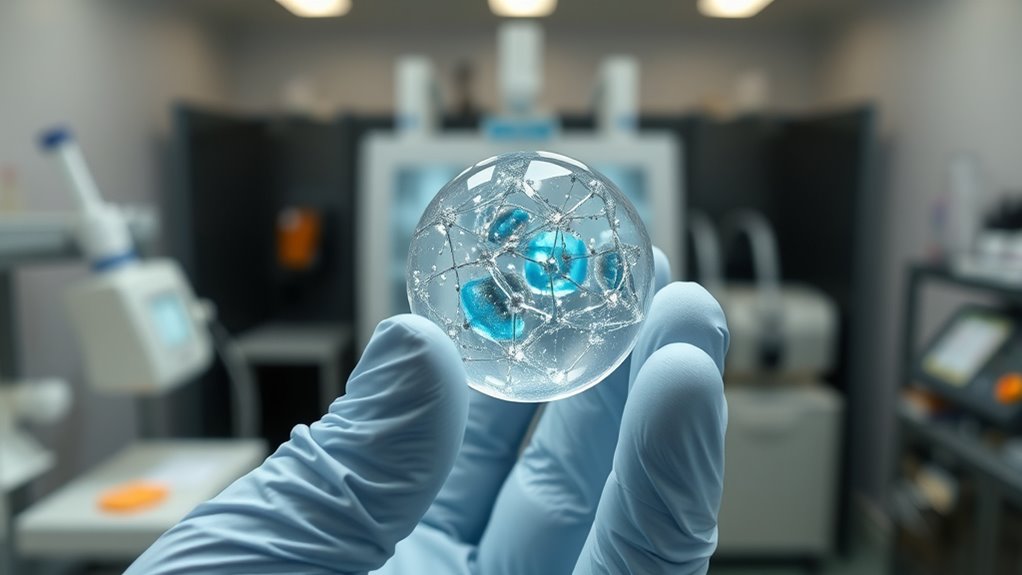When considering ethical frameworks for nanomedicine, it’s crucial to prioritize informed consent, ensuring patients understand risks, benefits, and uncertainties of nanotechnologies. Clear communication about safety protocols and potential long-term environmental impacts is essential to protect health and ecosystems. Establishing standardized safety procedures and regulatory oversight helps manage risks effectively. These principles promote responsible innovation while respecting patient autonomy—if you want to explore how these elements work together, there’s more to discover.
Key Takeaways
- Informed consent in nanomedicine must transparently communicate complex risks, benefits, and uncertainties to respect patient autonomy.
- Establishing standardized safety protocols and regulations ensures consistent risk management and environmental protection in nanomedical applications.
- Continuous monitoring and rigorous testing are essential to evaluate long-term safety and prevent ecological and health hazards.
- International coordination and public engagement foster responsible innovation, transparency, and societal trust in nanomedicine development.
- Ethical frameworks should balance innovation with safety, emphasizing honest communication, environmental considerations, and inclusive stakeholder involvement.
The Significance of Informed Consent in Nanomedicine

Why is informed consent particularly critical in nanomedicine? Because nanotechnology involves manipulating materials at an atomic or molecular level, the risks and benefits aren’t always fully understood. You need to know what you’re agreeing to, especially since potential long-term effects might be unknown or unpredictable. Unlike traditional medicine, nanomedicine introduces tiny particles that can interact with your body in new, unforeseen ways. This complexity makes transparent communication essential. When you give informed consent, you’re not just agreeing to a treatment; you’re understanding its possible risks, benefits, and uncertainties. This process respects your autonomy and ensures you’re making an educated decision. Without proper informed consent, you might unknowingly expose yourself to risks that haven’t been fully evaluated.
Challenges in Communicating Nanotechnology Risks to Patients

Communicating the risks of nanotechnology to patients presents unique challenges because the science is complex and often unfamiliar. You may struggle to explain how nanoscale materials behave differently from traditional medicines, making potential risks harder to grasp. Patients might find technical jargon confusing, leading to misunderstandings or undue fear. Additionally, the long-term effects of nanomaterials are still uncertain, which complicates risk disclosure. You need to balance honesty about unknowns with reassurance, all while avoiding unnecessary alarm. Effectively conveying these risks requires simplified explanations, visual aids, and honest dialogue. Clear communication helps patients make informed decisions, but the novelty of nanomedicine makes it difficult to ensure they fully understand potential dangers and benefits. This gap can impact trust and ethical responsibility. Moreover, Vetted – Halloween Product Reviews could serve as a useful analogy for evaluating and communicating the reliability of information about nanotechnology risks.
Developing Standardized Safety Protocols for Nanomaterials

Developing standardized safety protocols for nanomaterials is essential to guarantee consistent risk management and protect public health. Without clear guidelines, safety measures can vary, increasing the chance of accidents or unintended exposure. To create effective protocols, you should focus on:
- Establishing uniform testing procedures to assess nanomaterial toxicity and environmental impact.
- Defining safe handling, storage, and disposal methods tailored to different nanomaterials.
- Implementing continuous monitoring systems for early detection of potential hazards during production and use.
- Incorporating water safety measures, especially considering the potential for nanomaterials to contaminate aquatic environments.
These steps help ensure that nanomaterials are used responsibly and safely across industries. By standardizing safety practices, you reduce risks, build public trust, and support responsible innovation in nanomedicine.
Ethical Considerations in Clinical Trials Involving Nanomedicine

When conducting clinical trials with nanomedicine, you need to carefully address informed consent, ensuring participants understand the unique risks involved. You also have to establish rigorous risk assessment protocols to evaluate potential hazards accurately. Additionally, adhering to strict regulatory oversight standards helps protect participants and maintain ethical integrity throughout the trial process. Incorporating safety protocols that are specific to nanomedicine can further enhance participant protection and ensure responsible research practices.
Informed Consent Challenges
Informed consent poses significant challenges in nanomedicine clinical trials because the complex nature of nanotechnology makes it difficult for you to fully grasp the risks and benefits involved. Nanoparticles can behave unpredictably, and their long-term effects are often unknown. This uncertainty complicates your understanding of potential safety concerns. To navigate these challenges, consider:
- The difficulty in explaining complex nanotech processes clearly.
- The risk of unintentionally understating possible side effects.
- The challenge in ensuring truly informed decisions amid scientific uncertainty.
- The increasing importance of data privacy challenges in safeguarding your personal health information during research.
These factors can hinder your ability to give fully informed consent, raising ethical questions about your autonomy and understanding in nanomedicine research.
Risk Assessment Protocols
How do researchers guarantee that nanomedicine clinical trials are conducted ethically when evaluating potential risks? They implement thorough risk evaluation protocols that identify and analyze possible hazards associated with nanomaterials. These protocols require you to evaluate toxicity, biodistribution, and long-term effects, considering nanomaterials’ unique behaviors. You must gather data from laboratory studies, preclinical tests, and existing literature to anticipate adverse outcomes. Transparency is essential; you document all findings meticulously to inform decision-making. You also need to establish safety thresholds and monitoring systems to detect unexpected effects during trials. Additionally, understanding nanomaterials’ unique behaviors can help in designing more accurate safety assessments. By rigorously assessing risks beforehand, you help protect participants and uphold ethical standards, ensuring that the potential benefits of nanomedicine outweigh the possible harms.
Regulatory Oversight Standards
Regulatory oversight standards serve as the backbone for ensuring ethical conduct in nanomedicine clinical trials. You need clear guidelines to protect participants and maintain public trust. These standards include strict review processes to evaluate safety data, adherence to international regulations, and ongoing monitoring throughout the trial. Additionally, comprehensive documentation and transparency are crucial to facilitate accountability and informed decision-making. Risk management strategies are essential components to anticipate and mitigate potential hazards during the development and testing phases.
Balancing Innovation With Patient Autonomy

Balancing innovation in nanomedicine with patient autonomy presents a complex ethical challenge. As a patient, you want access to cutting-edge treatments that could improve your health, but you also deserve full control over your medical decisions. Developers and clinicians must guarantee you’re fully informed about the risks, benefits, and uncertainties involved in nanomedical therapies. You should have the freedom to accept or decline treatments based on your values and preferences. However, rapid technological advances can pressure you to make quick decisions without complete information. It’s essential that your autonomy is prioritized, even as innovation pushes the boundaries of medicine. Transparent communication, informed consent, and respect for your choices remain central to ethically balancing progress with your rights. Additionally, understanding the role of contrast ratio in image quality can serve as an analogy for how critical clarity and transparency are in conveying complex medical information.
Regulatory Frameworks and Oversight for Nanomedical Treatments

You need to understand how international regulatory coordination shapes nanomedical treatments, ensuring consistent standards across borders. Safety and efficacy standards are central to protecting patients and guiding responsible innovation. Addressing these points helps create a robust oversight framework that keeps pace with rapid technological advances.
International Regulatory Coordination
How can international collaboration guarantee the safe and effective development of nanomedical treatments? By establishing unified standards, sharing research data, and coordinating oversight efforts, you can assure treatments meet global safety and efficacy benchmarks. International agencies like the WHO and regulatory bodies across countries work together to create harmonized frameworks that prevent fragmented regulations. This collaboration helps identify potential risks early, streamlines approval processes, and promotes transparency. Additionally, adhering to best practices in anime movies can inspire innovative ways to visualize complex scientific concepts, making information more accessible and engaging for diverse audiences.
Here are three ways to strengthen coordination:
- Develop global guidelines for nanomedicine safety and ethics.
- Share research findings to accelerate innovation and prevent duplication.
- Coordinate monitoring and post-market surveillance to address cross-border risks effectively.
Safety and Efficacy Standards
Establishing robust safety and efficacy standards is essential to ensuring that nanomedical treatments are both effective and safe for patients worldwide. You need clear regulatory frameworks that evaluate nanomaterials’ potential risks and benefits through rigorous testing. These standards should include preclinical assessments, clinical trials, and ongoing monitoring to identify any adverse effects early. By setting uniform benchmarks, you help prevent unsafe products from reaching the market and build public trust in nanomedicine. Regulatory agencies must stay updated on technological advances to adapt oversight accordingly. You also have a role in promoting transparency and accountability, ensuring developers adhere to high safety standards. Incorporating dog names into clinical research can also aid in understanding the behavioral impacts of nanomedical interventions. Ultimately, strong safety and efficacy standards protect patients, support innovation, and foster responsible growth in nanomedicine.
Addressing Long-term Safety and Environmental Impact

What are the long-term safety and environmental risks associated with nanomedicine? You need to recognize potential issues that could arise over time. First, nanoparticles might accumulate in the body or environment, causing unforeseen health effects. Second, they could interact with existing ecosystems, disrupting balance or harming wildlife. Third, the durability of nanomaterials may lead to persistent pollutants that are difficult to remediate. Fourth, the suction power of nanomaterials can influence how they interact with biological systems and ecosystems, potentially leading to unforeseen consequences. These risks underscore the importance of thorough, ongoing research to monitor long-term impacts. You must also develop strict regulations to ensure safe disposal and minimize environmental release. Addressing these concerns proactively helps prevent future health crises and ecological damage, ensuring nanomedicine advances responsibly and sustainably.
Fostering Public Engagement and Transparent Dialogue

To foster public engagement and guarantee transparent dialogue, it’s crucial to actively involve diverse communities in discussions about nanomedicine. You should create accessible platforms where people can ask questions, share concerns, and provide feedback. Use clear language, avoiding technical jargon, to ensure everyone understands the potential benefits and risks. Encourage open forums, community meetings, and online resources that promote two-way communication. By doing so, you help build trust and demonstrate that public opinions matter in shaping nanomedical innovations. Additionally, transparency about research processes, safety measures, and ethical considerations reassures the public and fosters informed decision-making. Engaging communities early and consistently helps align nanomedicine development with societal values and promotes responsible innovation.
Frequently Asked Questions
How Do Cultural Differences Influence Consent Processes in Nanomedicine?
Cultural differences shape how you approach consent in nanomedicine by influencing your perceptions of authority, trust, and individual autonomy. You might prioritize family or community approval over individual decision-making, or have varying beliefs about scientific intervention. Recognizing these differences helps you respect diverse values, ensuring informed consent that aligns with cultural contexts. By adapting your communication, you foster trust and facilitate ethically sound decisions tailored to each person’s cultural background.
What Ethical Issues Arise From Nanomedicine Applications in Vulnerable Populations?
Have you considered the ethical dilemmas nanomedicine poses for vulnerable populations? You might worry about informed consent, as these groups often face power imbalances or cognitive challenges. You also need to guarantee their safety isn’t compromised, avoiding exploitation or unintended harm. Are protocols strict enough to protect these groups? Addressing these issues requires careful ethical oversight, transparency, and tailored communication to respect their unique vulnerabilities and needs.
How Can Patient Privacy Be Protected With Nanotechnology Data Sharing?
You can protect patient privacy by implementing strict data encryption and access controls, ensuring only authorized personnel can view sensitive information. Regular audits and compliance with data protection laws help identify and address vulnerabilities. Educate patients about how their data is used and obtain informed consent for sharing. Using anonymization techniques also minimizes the risk of identifying individuals, keeping their personal details safe in nanotechnology data sharing.
Are There International Standards for Safety Testing of Nanomaterials?
Yes, there are international standards for safety testing of nanomaterials, though they’re still evolving. Agencies like the OECD and ISO develop guidelines to confirm consistent testing protocols, focusing on toxicity, environmental impact, and biocompatibility. You should stay updated with these standards, as they help you evaluate risks properly. Following these guidelines enables you to responsibly develop and implement nanomaterials while safeguarding health and the environment.
How Do Economic Disparities Affect Access to Nanomedical Treatments?
Economic disparities profoundly impact your access to nanomedical treatments. If you’re in a wealthier country or community, you’re more likely to receive advanced therapies, while those in poorer areas face barriers like high costs, limited infrastructure, and lack of awareness. These inequalities mean that your ability to benefit from nanomedicine depends heavily on your financial situation and geographic location, creating a gap in equitable healthcare access worldwide.
Conclusion
As you navigate the evolving landscape of nanomedicine, remember that your voice is the compass guiding ethical progress. Just as a lighthouse illuminates safe passage through dark waters, transparent dialogue and informed consent steer innovation toward trust and safety. Embrace your role in shaping policies and fostering understanding, ensuring that this tiny technology respects your autonomy and protects our shared future—because in the end, your awareness lights the way forward.









